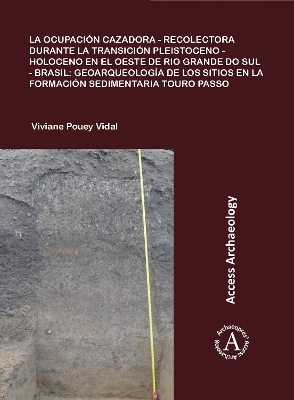
La ocupación cazadora-recolectora durante la transición Pleistoceno-Holoceno en el oeste de Rio Grande do Sul - Brasil: geoarqueología de los sitios en la formación sedimentaria Touro Passo
Archaeopress Access Archaeology (Verlag)
978-1-78491-913-9 (ISBN)
This book presents the results obtained during geoarchaeological studies carried out in the locality of Touro Passo, municipality of Uruguaiana, Brazil. There, the Paleoindian sites studied by the team of the PRONAPA-National Archaeological Research Program in the 1960s and 1970s were relocated and others with excellent study potential have been recognized. The archaeological sites are located in the alluvial plains of the Uruguay River and the Touro Passo Stream and correspond to the late Pleistocene-early Holocene transition. The geoarchaeological approach allowed the understanding of the stratigraphic sequence and the processes of formation and post-depositional disturbance of the archaeological sites in a fluvial environment. Archaeological excavations, soundings, stratigraphic profile surveys, sequence correlations and numerical dates were carried out. The dispersion of artifacts on the surface and cave erosion was recorded, and a lithic taphonomy study was carried out. Four Paleoindian sites located in the Touro Passo Formation were analyzed: Barranca Grande, RS-I-66: Milton Almeida, RS-I-69: Laranjito and Casualidade. The new chronologies obtained for the initial period of human occupation in the region represent a scientific advance for the study of hunter-gatherer occupations during the Late Pleistocene-Early Holocene in the triple border of Brazil, Argentina and Uruguay. | Este libro presenta los resultados obtenidos durante los estudios geoarqueológicos realizados en la localidad Touro Passo, municipio de Uruguaiana, Brasil. Alli se reubicaron los sitios paleoindios estudiados por el equipo del PRONAPA-Programa Nacional de Investigaciones Arqueológicas en las décadas de 1960 y 1970 y han sido reconocidos otros con excelente potencial de estudio. Los sitios arqueológicos están situados en las planicies aluviales del Río Uruguay y del Arroyo Touro Passo y corresponden a la transición Pleistoceno tardío-Holoceno temprano. El enfoque geoarqueológico permitió la comprensión de la secuencia estratigráfica y los procesos de formación y perturbación postdepositacional de los sitios arqueológicos en ambiente fluvial. Fueron realizadas excavaciones arqueológicas, sondeos, relevamiento de perfiles-estratigráficos, correlaciones de secuencias y fechados numéricos. Se registró la dispersión de los artefactos en superficie y en las cárvavas de erosión, y se realizó, un estudio de tafonomía lítica. Se analizaron 4 sitios paleoindios situados en la Formación Touro Passo: Barranca Grande, RS-I-66:Milton Almeida, RS-I-69: Laranjito y Casualidade. Las nuevas cronologías obtenidas para el período inicial de ocupación humana en la región, representan un avance científico para el estudio de las ocupaciones cazadoras-recolectoras durante el Pleistoceno tardío-Holoceno temprano en la triple frontera Brasil, Argentina y Uruguay.
Viviane Pouey Vidal has a PhD in Archaeology (Faculty of Social Sciences, UNICEN-National University of the Center of the Province of Buenos Aires-Olavarría). She is a researcher at the GEGAL - Group of Geoarchaeological Studies of Latin America. She was a PhD Fellow abroad by the CAPES - Coordination of Improvement of Higher Level Personnel. She acted as University teacher in the Interdisciplinary Degree Course in Human Sciences at UNIPAMPA - Federal University of Pampa, São Borja Campus / Rio Grande do Sul (2015/2017). She is a member of the Frontier Relations Research Group: History, Politics and Culture in the Triple Frontier Brazil and Uruguay (CNPq-Federal University of Pampa). She is the author of the PPC- Pedagogical Project of the Bachelor's Degree Course in Archaeology that aims to be implemented in the UNIPAMPA. She acts as a consultant in archaeological and patrimonial research in environmental licensing, with experience in Precolonial research and Patrimonial Education. | Viviane Pouey Vidal es Doctora en Arqueología (Facultad de Ciencias Sociales, UNICEN-Universidad Nacional del Centro de la Provincia de Buenos Aires-Olavarría. Es investigadora del GEGAL - Grupo de Estudios Geoarqueológicos de América Latina. Fue becaria de Doctorado Pleno en el Exterior por la CAPES - Coordinación de Perfeccionamiento de Personal de Nivel Superior. Es licenciada en Historia con Maestría en Historia de las Sociedades Ibéricas y Americanas por la PUC-Pontificia Universidad Católica de Rio Grande do Sul con dirección y investigaciones de tesis en arqueología precolonial. Durante los estudios de doctorado, también cursó disciplinas en la graduación en arqueología nivelando su licenciatura. Actuó como Profesora Universitaria en el Curso de Licenciatura Interdisciplinaria en Ciencias Humanas en la UNIPAMPA - Universidad Federal del Pampa, Campus São Borja / Rio Grande del Sur (2015/2017). Es miembro del Grupo de Investigación Relaciones de Frontera: Historia, Política y Cultura en la Triple Frontera Brasil y Uruguay (CNPq-Universidad Federal de Pampa). Es autora del PPC- Proyecto Pedagógico de Curso de Bachillerato en Arqueología que pretende ser implantado en la UNIPAMPA. Actúa como consultora en investigaciones arqueológicas y patrimoniales en licenciamientos ambientales, con experiencia en investigaciones Precoloniales y Educación Patrimonial.
CAPÍTULO 1. INTRODUCCIÓN; CAPÍTULO 2. ANTECEDENTES DE INVESTIGACIÓN; CAPÍTULO 3. MARCO GEOGRÁFICO Y AMBIENTAL DEL ÁREA DE ESTUDIO; CAPÍTULO 4. PALEOAMBIENTES, FAUNA PLEISTOCÉNICA Y VEGETACIÓN EN EL RIO URUGUAY Y ARROYO TOURO PASSO; CAPÍTULO 5. METODOLOGÍA; CAPÍTULO 6. PROSPECCIONES ARQUEOLÓGICAS EN LA CUENCA DEL RÍO URUGUAY Y EN LA SUBCUENCA DEL ARROYO TOURO PASSO: REUBICACIÓN Y UBICACIÓN DE NUEVOS SITIOS; CAPÍTULO 7. LOS SITIOS ARQUEOLÓGICOS EN LA FORMACIÓN SEDIMENTARIA TOURO PASSO: PROCESOS DE FORMACIÓN Y PERTURBACIÓN POSTDEPOSICIONAL; CAPÍTULO 8. EL ESTUDIO GEOARQUEOLÓGICO EN LOS SITIOS DEL RIO URUGUAY; CAPÍTULO 9. LOS CONJUNTOS ARTEFACTUALES DE LOS CAZADORES - RECOLECTORES EN LA TRANSICIÓN PLEISTOCENO - HOLOCENO:UN BREVE ANÁLISIS TAFONÓMICO Y TECNOLÓGICO; CAPÍTULO 10. DISCUSIONES DE LOS RESULTADOS; CAPÍTULO 11. CONCLUSIONES; BIBLIOGRAFIA
| Erscheinungsdatum | 19.09.2018 |
|---|---|
| Zusatzinfo | 217 illustrations; 33 tables (119 colour plates) |
| Sprache | spanisch |
| Maße | 203 x 276 mm |
| Gewicht | 859 g |
| Themenwelt | Sachbuch/Ratgeber ► Geschichte / Politik ► Vor- und Frühgeschichte / Antike |
| Geisteswissenschaften ► Archäologie | |
| Geschichte ► Allgemeine Geschichte ► Vor- und Frühgeschichte | |
| ISBN-10 | 1-78491-913-6 / 1784919136 |
| ISBN-13 | 978-1-78491-913-9 / 9781784919139 |
| Zustand | Neuware |
| Haben Sie eine Frage zum Produkt? |
aus dem Bereich


